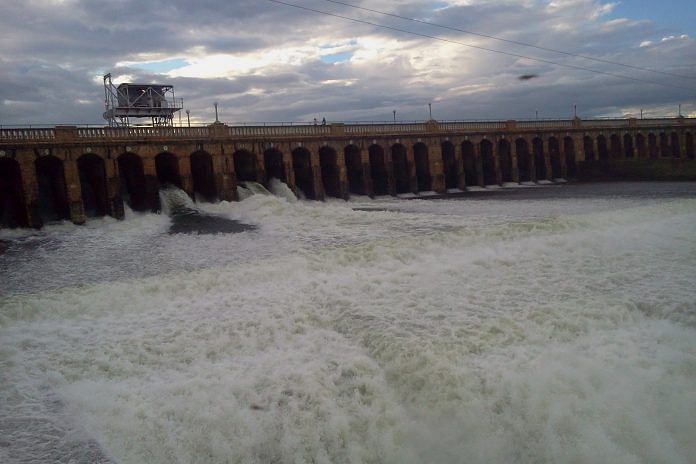It is doubtful that even the most judicious settlement of the Cauvery issue will satisfy Karnataka and Tamil Nadu.
A late burst of the southwest monsoon in late September ensured that Karnataka and Tamil Nadu will not go through, at least for now, their annual ritual of battling over Cauvery river water.
But reservoirs in Karnataka aren’t full yet. So this crisis might still unfold if Tamil Nadu asks the Supreme Court to ensure that Karnataka releases 134 TMC of backlog water which was due to it between June and September.
Still, we may be seeing the endgame of this 43-year-old dispute. On 21 September, the Supreme Court concluded its 10-year long hearings over the Cauvery Water Dispute (CWDT) award, reserved its orders and asked the four disputants — Karnataka, Tamil Nadu, Kerala and Puducherry — to submit written responses to various issues that arose during the hearings.
The final judgement is expected by the time SC’s annual term ends in April 2018. CWDT, constituted as per the Supreme Court directions in 1990, deliberated for 17 years, before apportioning Cauvery waters among the four claimants. The dispute had arisen because the most recent Cauvery water sharing agreement, arranged between what was then the Madras Presidency and Mysore princely kingdom in 1924, had expired in 1974.
Since then, the competing claims have turned the Cauvery dispute into perhaps the most fractious interstate water sharing conflict in India. The Supreme Court has gotten involved for decades now not only in matters related to the CWDT but also in more mundane water sharing arrangements, especially during monsoon deficit years.
The upcoming court verdict should ultimately settle the matter because the disputants do not have any further legal or administrative avenues available. But it is doubtful whether Karnataka and Tamil Nadu will reconcile to even the most judicious settlement. This is because both the states have constructed irreconcilable narratives, nursing an intense sense of being unjustly deprived and historically wronged.
Karnataka has consistently argued that the two original agreements of 1892 and 1924 favoured Tamil regions, because the stronger Madras Presidency could browbeat the weaker Mysore and thereby get a greater share of Cauvery water. Such an advantage, Karnataka believes, enabled Tamil Nadu to irrigate districts in the Cauvery delta, and thus establish its prior appropriation right.
Karnataka, on the other hand, couldn’t build any reservoirs until after the 1924 agreement ended and began to harness water from the tributaries of Cauvery only in the 1970s and 1980s. Cauvery itself couldn’t be touched. To overcome this historical injustice, Karnataka has begun making an absolute claim over Cauvery water collected in its catchment area, asserting that it will release water to Tamil Nadu only after its basic needs are met. Despite the merits of Karnataka’s case, its absolute claims are legally not tenuous.
In contrast, Tamil Nadu not only asserts its lower riparian state rights based on the principle of prior appropriation, it also argues that Karnataka’s claims over Cauvery water for irrigation and drinking purposes are unjust because the latter built its reservoirs surreptitiously, without securing proper permissions. Tamil Nadu is also furious over Karnataka’s recent move to fill its tanks in southern Karnataka with Cauvery waters. Prof. Janakarajan, an economist at MIDS, has often accused Karnataka of turning Cauvery into a sewage channel, by transferring water at will.
Neither state is happy with the CWDT award. Karnataka is displeased that the Tribunal upheld the above mentioned prior agreements and used them as the basis for apportioning water now. Such an approach, Karnataka believes, has led the Tribunal to deny drinking water to Bangalore city, which falls within the Cauvery basin. On the other hand, Tamil Nadu claims that the Tribunal underestimated its water needs by considering only one crop.
Both the narratives are largely true. And therein lies the problem. Both Karnataka and Tamil Nadu have attempted to maximally utilise Cauvery waters, blatantly or through subterfuge, whenever they had an opportunity. Consequently, there is barely enough water to meet the demands of both states during a normal monsoon year, let alone deficit years.
But in these days of climate change, monsoon rainfall patterns too have become unpredictable. So the CWDT’s award too has become irrelevant, since the historical data that the Tribunal used for its water sharing formula has become obsolete. Moreover, CWDT mandated monthly targets for water release, which also is impossible to implement practically.
From the hearings, it appeared that the Supreme Court favours the formation of a Cauvery Management Board (CMB), as mandated by the Tribunal. Karnataka strongly opposes CMB, and Tamil Nadu wants it formed immediately. Such management boards, with representatives from the centre as well as all the concerned states, have become the norm and they manage all the reservoirs.
Karnataka itself participates in the Tungabhadra Management Board, which has functioned quite smoothly. However, the Cauvery Management Board might turn out to be intractable for this river system is overexploited. Under these circumstances, even a neutral, professional and competent CMB faces a Herculean task.
Well-meaning attempts by intellectuals and farmers of the Cauvery delta to amicably share Cauvery waters never took off. And there haven’t been more organised efforts, by the state governments or civil society organisations, to change cropping patterns, and shift away from water-intensive crops. Nor have there been attempts to adopt more efficient usage water strategies such as the use of sprinklers or drip irrigation.
There is also a new lurking fear. In the near future, Cauvery dispute will not remain just an interstate water dispute. As water needs of urban areas increase, intra-state disputes will be quite common throughout the Cauvery delta. We can already see emerging conflicts between the irrigation demands of Mandya farmers and drinking water needs of Bangalore. In the absence of legally delineated water rights doctrine, such conflicts will intensify, testing both our intellect and imagination. Given this reality, the Supreme Court judgment, whenever it is delivered, may not be of much help.



